Hidden treasure
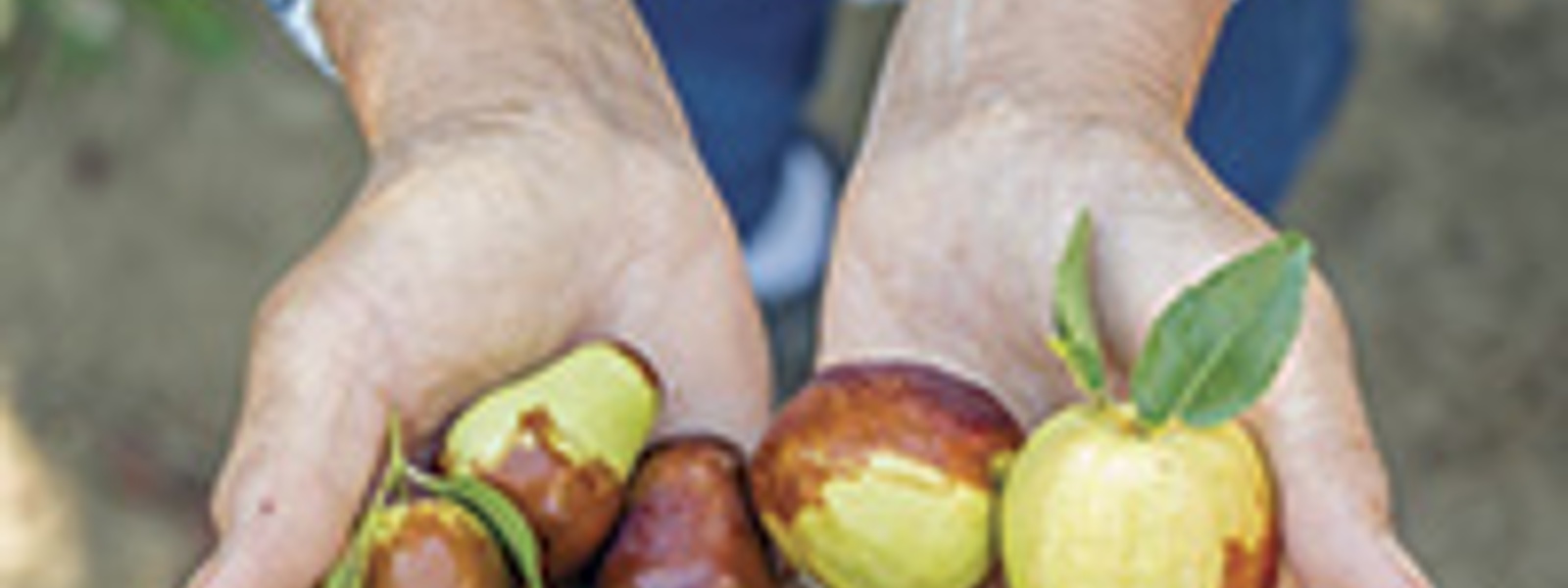
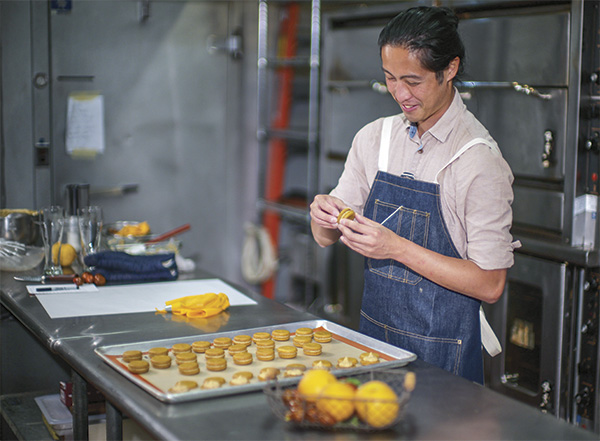
Pastry chef Eric Szeto assembles ginger pear macarons—a type of French cookie—which he fills with a jujube and Asian pear ganache. Photo: © 2018 Manny Crisostomo
Apple, pumpkin, spice and everything nice: That's what fall flavor is made of. But a lesser-known fruit of the season also deserves notice.
Meet the jujube, an exotic fruit with an unusual name. It's one most people associate with the gummy movie theater candy, not these tasty, snackable mini-fruits. Jujubes are small, crunchy—almost woody—with a mild flavor reminiscent of apple, pear and date. Crisp and sweet, they're easy and satisfying to eat by the fistful—but chances are you've never tasted one. A small but growing number of farmers and chefs are hoping to change that.
Eric Szeto, the talent behind Oakland-based Shades of Sugar Bakeshop, is one of them. He specializes in artisan macarons—the classic French cookie with ganache or jam fillings sandwiched between two almond-flour meringue wafers. Szeto crafts his innovative flavors from local produce. He became a recent convert to jujube fandom, after he tasted fresh jujubes at a farmers market.
"I was looking at what would pair well with pears and apples," he said. "Jujubes came up and I tried some of them. They're similar to apples, but they're kind of more tart."
A bite into the resulting ginger pear macaron yields layers of surprises in both texture and flavor. The macaron cookies are light and crisp outside, dense and chewy inside. The sweet flavor of hosui Asian pear in the filling is tempered by a hidden supporting star: jujubes from K&J Orchards in Yuba City and Winters. Ginger provides a spicy counterpoint, and the result is all the flavors of fall in one bite.
"We try to find that melody, that perfect balance of flavor," Szeto said. "The jujubes accentuate that essence of pear and apple flavor. People were blown away by it."
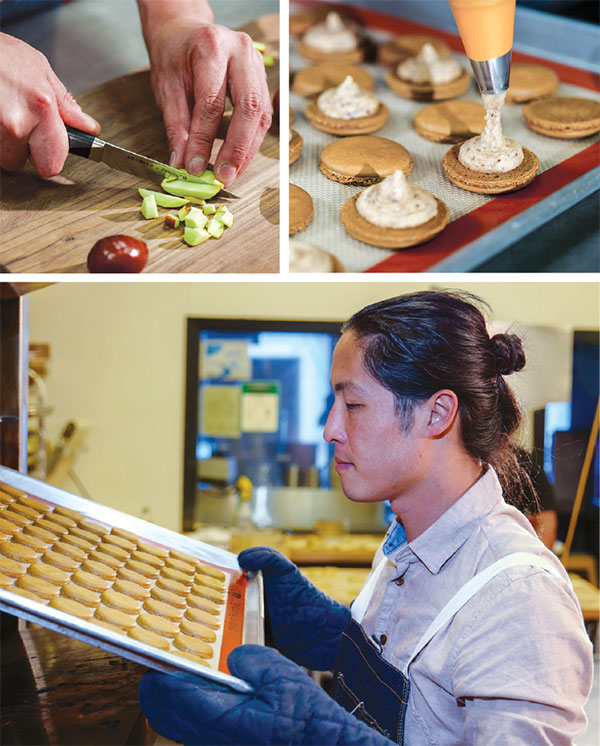
Szeto bakes macarons, above. For the filling, he dices fresh jujubes, top left, and Asian pears, and simmers them. The resulting puree is added to ganache and piped onto cookies, top right. Photos: © 2018 Manny Crisostomo
East to west
Jujubes, also known as Chinese red dates, have been cultivated in their native China for more than 4,000 years. High in antioxidants and an excellent source of vitamin C, they've long been valued in traditional Chinese medicine, as well as prized for their culinary properties. Most commonly available as a dried product, jujubes are used to make tea and desserts and added to soups, stews and porridge.
Jujubes were introduced to Europe more than 1,500 years ago via the Silk Road. But it wasn't until 1908 that a U.S. Department of Agriculture explorer introduced the first commercial cultivars to America at the USDA Plant Introduction Station in Chico. It's remained a niche crop, one mainly available from small farms at farmers markets.
Kalayada Beutel, co-founder of K&J Orchards, is one of the fruit's champions. She was familiar with jujubes from her childhood in Thailand. Her parents and aunt had been farmers, instilling in her a passion for great-tasting produce that followed her to the United States.
In 1980, as a single mother working as a registered nurse in Sacramento, she wanted to satisfy her appetite for fresh Asian pears, which were hard to find at that time. She decided to add farming to her list of roles, taking a second job to pay for a 40-acre farm in Yuba City, about 40 miles north of Sacramento.
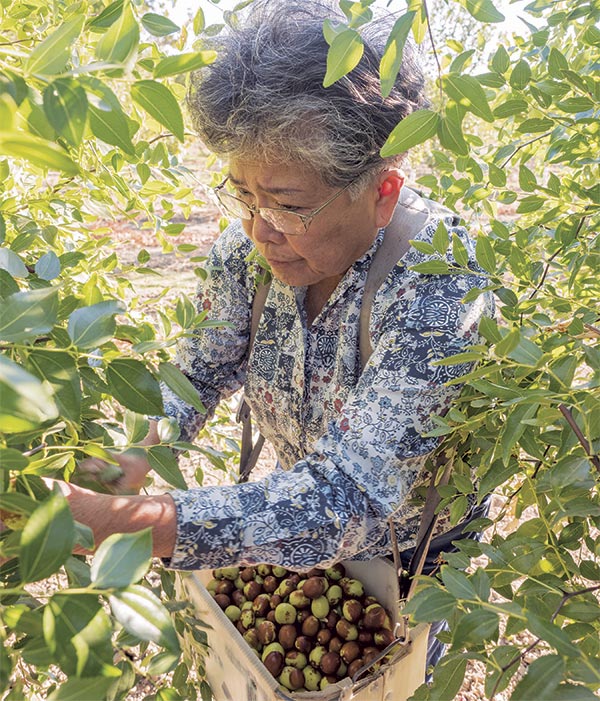
Kalayada Beutel hand-harvests jujubes on her farm in Winters. The fruit is popular in its native Asia, but remains lesser-known in California, where it is in season September and October. Photo: © 2018 Ron Nabity
A new market
Along with Asian pears, Beutel planted jujubes, a delicacy she enjoyed for Chinese New Year when she was a girl. James Beutel, a pomologist and Asian pear expert at the University of California, Davis, with whom she consulted and who later became her husband, advised her to also plant fruits that would be more recognizable to the American customers at farmers markets, such as peaches and apples, and helped her learn the basics of farming.
After the couple married, they added a farm in Winters to the operation, becoming K&J Orchards. They remained partners in the farm until his death a few years ago. Today, K&J Orchards sells a diverse selection of fruits spanning all seasons at 10 Bay Area farmers markets and directly to restaurants.
Beutel said that in those early years, she was the only farmer selling jujubes at the markets she attended.
"Nobody knew about Li and Lang until I started to bring it to farmers markets," she said, naming the two most common varieties.
She found a natural customer base among people originally from Asia, Southeast Asia and the Middle East and their families, who were familiar with the fruit. For other customers, she offered free samples to entice them.
To win over customers, Beutel knew she had to make the jujubes as delicious as possible. She tinkered with her trees, experimenting to coax out better-tasting fruit and optimal production. She learned how to prune the trees properly and thin out the fruit so that the remaining ones would grow larger, with more concentrated sugars.
Once people taste them for the first time, they often want to take some home, she said. Fresh jujubes are excellent for snacking, peel and all, eating like tiny, very crisp apples studded with a small, inedible pit.

Beutel, center above, daughter Aomboon Deasy and son-in-law Tim Deasy run K&J Orchards together. Above left, Beutel displays freshly harvested Lang jujubes. Li jujubes tree, above right. Photos: © 2018 Ron Nabity
Flavor is king
The farm harvests jujubes in September and October. In the beginning of the season, the fruits are green and crunchy. As they mature, they begin to develop brown speckles, then brown patches, and get sweeter. Many customers prefer fresh jujubes when they're about half brown and green. They can continue to ripen on the countertop. If they stay on the tree, they'll turn dark reddish-brown and reach maximum sweetness and become spongy, after which they can be dried.
The Li variety is the larger of the two, with round fruit that's best eaten fresh. Lang has smaller, pear-shaped fruit that becomes sweeter as it colors, and is a variety traditionally used for drying, but can also be eaten fresh. Beutel also has a less-common variety, Sherwood, with great flavor and sweetness, that's a little trickier to grow commercially.
Jujubes are adaptable and relatively easy to grow, tolerating drought and heat and suffering from no known pests or diseases in California. These qualities, coupled with a growing appetite among consumers for unusual fruit varieties, have encouraged more farmers to grow them.
Beutel's daughter Aomboon Deasy, who is involved in the family business along with her husband, Tim, said she's beginning to see more farmers sell jujubes at markets. Asian grocers are also now carrying fresh, California-grown jujubes, where dried were once the norm.
Beutel insists that if jujubes are to truly win over American customers, quality is key. It's a philosophy she applies not only to jujubes, but to every fruit variety she grows.
"I want to create a very, very good fruit," she said. "That's why I'm so picky about picking fruit. It's got to be nice and ripe and handpicked."
Beutel's exacting standards have helped the farm win customers among top chefs in the Bay Area and Napa Valley. A list of the 150 restaurants it supplies, a few of which have featured jujubes as an ingredient on their menus, reads as a Michelin-star-studded culinary tour of the region.
But hearing rave reviews from everyday market customers is just as important to Beutel.
"I'm really happy to make money to feed my employees," she said. "But by the same token, I'm happy because people enjoy my fruit."
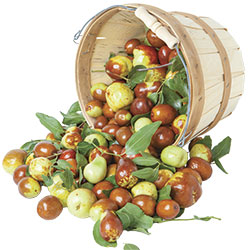
Did you know?
- One of the richest sources of vitamin C of all fruits, just one to three jujubes can supply your entire recommended daily allowance. They're also high in potassium.
- In China, there are more than 800 jujube cultivars. In the U.S., two dominate: Li and Lang.
- Jujubes have a much higher concentration of natural sugars than apples, grapes and peaches.
- Dried jujubes are used in traditional Chinese and Middle Eastern medicine to improve sleep, mood, circulation and digestion.
- Fresh jujubes can be used in recipes much like apples: in salads, crisps, tarts, jams, fruit butters and cakes, or added to stuffing.
- Dried jujubes can substitute for dates or raisins in baked goods, such as muffins, cookies and scones.

